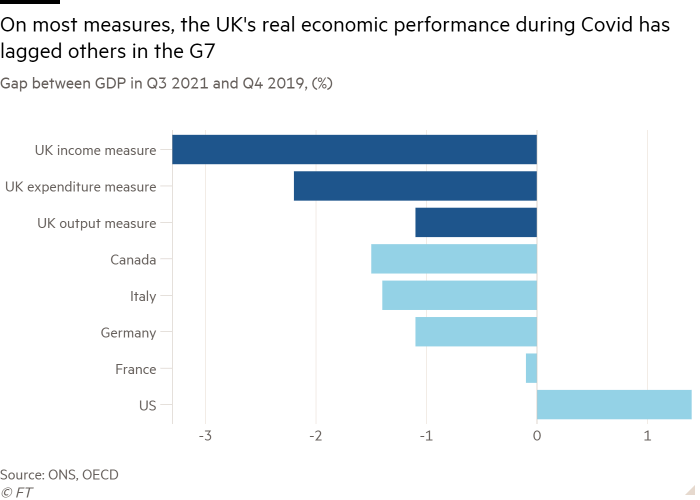Here is a simple question. Has the UK economy already recovered all of the ground lost during coronavirus, or is the damage wrought by Covid-19 so severe that it will take another two years of normal growth rates to return activity to its pre-pandemic level?
It may come as a surprise that the official answer, according to the UK’s Office for National Statistics, is that both statements are true. Measured by the value of goods and services produced, the real level of UK output was only 0.6 per cent below the pre-pandemic level in September and, by now, will almost certainly have reached that benchmark. But on another official statistic, the shortfall is still 3.3 per cent, roughly the equivalent of two years of recent UK average growth rates.
For most people, this is the moment when you throw your arms up into the air and scream that economics never gives a straightforward answer. Policymakers, such as those at the Bank of England, tend to dust down their treasured weasel words for such situations and term the outlook to be “unusually uncertain”. Generally, they also seek to avoid changing policy when the present, let alone the future, is so uncertain.

But this is not the moment to give up and go home. After a careful analysis of the UK’s national accounts and those of other countries, consistent stories do emerge from the mist with pretty clear policy prescriptions.
Going back to first principles, we should not be surprised that data discrepancies such as these exist. One of the first things people learn on macroeconomics courses is that there are three ways to measure the size of an economy and its growth rate.
Statisticians can measure the output of goods and services produced, they can assess the expenditure required to purchase this output and they can quantify the income received in the form of wages and profits by those supplying the goods and services. All three, by definition, are equal, but measurement error will normally create small differences between them in practice.

The problem at the moment in the UK is that the discrepancies are huge. Measured by output, the UK’s coronavirus recovery in real terms is close to its European peers in the G7 but behind the US. Performance looks worse when the expenditure or income measures are used, with the UK economy trailing the G7 pack.
None of this is quite the picture Rishi Sunak presents, of course. The chancellor likes to boast “we’re forecast to have the fastest growth in the G7 this year”, conveniently forgetting that 2021 covers only part of the pandemic.
Looking at the national accounts in real terms is not sufficient for a full reading of the economy, however, because adjusting expenditure, income and the value of output for inflation has been particularly difficult for statisticians during the pandemic. It is generally easier to measure the cash value of transactions, so nominal comparisons are crucial and probably more accurate.

Where data exist, these show the UK’s performance to be stronger internationally on all methods of measuring the economy. Whether it is nominal output, income or expenditure, the money flowing around the UK economy is already well above pre-pandemic levels and reasonably close to that of the US.
With figures for the nominal growth of the economy and estimates of the real change in the volume of goods and services produced, the implied domestic inflation rate since the end of 2019 is just above six per cent. That is the one part of the national accounts that really is top of the G7 league table.
Despite the data difficulties, there is then a truth visible in the mist surrounding the UK economy. It has probably performed worse than its peers, and it has almost certainly generated more domestic inflation. This is an economy that no longer needs emergency levels of stimulus.

